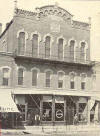Û Take a Walk Down Main Street
Anamosa, Iowa


 Shaw's Block |
 Another view This early 1900s view, provided by Mary Kay Kuhfittig, gives a better idea of the bustling atmosphere along Main Street. |
 and, another This view includes the "County Office" signs. Photo by D. W. Ellis from Picturesque Anamosa, compiled and published by W. Leon Hall, Cedar Rapids, Iowa, ca. 1900, and provided by Lois O'Donnell |
 West from Main & Huber On the corner across Huber street to the west was the Shaw & Schoonover Bank. Constructed in 1880 by W. T. Shaw, Lawrence Schoonover, E. M. Condit, Howard M. Remley and Thomas R. Ercanbrack. The limestone facing on the building was from Mt. Hope quarry in Stone City. The bank was located on the main floor while attorneys Remley & Ercanbrack, along with the Watertown Insurance Office, were on the second. In 1891-1892 the Y.M.C.A. operated a reading room at the rear of the second floor. The bank was eventually merged with Charles Lull's bank and was called the Anamosa National Bank. It collapsed during the 1930s depression. |
 Same in 1930 Next door to the bank is another William T. Shaw building. Today it houses the Starlighters Theatre, but for many years, begining in 1878, it was a hardware store. Owner's over the years were, J. G. Cudworth, I. P. Mienhart and (1908-1916) Hassen Monroe. Monroe sold out to a partnership of Messrs. Miller & Weber because of ill health, but bought the business back in 1919. He retired in July and died in September 1939. |
 and, in 1950s Begining in 1939, the site was occupied by a Ben Franklin store. The store was remodelled inside and out by the owner, Leo Loyet. At one time, including when this picture was taken, the store extended into the building formerly occupied by the bank. The Ben Franklin store was eventually replaced by Edward and Alice Redmond's Coast to Coast store. They sold the building to Starlighters Theatre in 1988. |
 Color view |
 Masonic Lodge The Masonic Lodge building was constructed by William T. Shaw in 1881. The Masons used the third story for their meetings. Strauss & Bro. operated a dry goods store of the first floor, as did a Mr. Plato. In February 1905, a fire damaged the building and caused the C. M. Beam furniture and undertaking business to close due to water damage to his inventory. It also forced renovation of the Masonic Lodge Room. The room was refinished with a steel ceiling, electric lighting, Brussels carpeting, new furniture and refinished woodwork. Other tenants have included: Morey Sickle (The Leader department store); Ament's; Breon's Clothing Store; and the Anamosa Bible Church. Photo by D. W. Ellis from Picturesque Anamosa, compiled and published by W. Leon Hall, Cedar Rapids, Iowa, ca. 1900, and provided by Lois O'Donnell |
 A little further along |
 Union Block |
 Bon Ton Restaurant T. L. Connery in his Bon Ton Restaurant, located at 110 E. Main Street. Photo by D. W. Ellis from Picturesque Anamosa, compiled and published by W. Leon Hall, Cedar Rapids, Iowa, ca. 1900, and provided by Lois O'Donnell |
 Conmey Hardware |
 Beam Drug This enlargement of the post card (photo by G. E. Cook) on the previous page shows Conmey's Hardware, the drug store—at this time operated by H. E. Beam, Peet & Cox dry goods/grocery, the bank and, the last two-story building before the alley, Alderman and Williams Grocery. Built by Horace Metcalf in 1863, it later became "George E. Noble, the Boss Grocer." The three-story building beyond the alley is the Odd Fellows Hall. Built in 1860 by William T. Shaw and Horace C Metcalf, the first floor housed the Metcalf and Hollenbeck store, the second floor the Eureka Printing Office and the third floor the Odd Fellows. Justice of the Peace J. J. Dickinson and the Dubuque Western Railroad also had space in the building. Next to the Odd Fellows was Anamosa Post Office building built in 1858 by Amos Peaslee. It was originally two stories with a third one added later. The last building shown, at the corner of Main and Garnavillo, is the Fisher House. |
 Fisher House |
 West of Garnavillo On the corner of Main and Garnavillo, across Garnavillo from the Fisher House, is Huggins & Belknap's Block. Constructed in 1872, by Burrill Huggins and John S. Belknap, it was originally a carriage and wagon works. By 1881 Huggins was in partnership with a man named Griffith and eventually they outgrew the building and relocatd on Davis Street near the Union depot. C. S. Clfin operated a broom and brush factory in the building, and later it became the Western Auto store. Other occupants: Modern Appliance, Tom Loder's funeral home and Nellie-Don florist. In 1881 the center building in the photo was built to "match" the corner block. Construction cost was $6,000 and all but $100 of that was in the bank. The building was owned by E. C. Holt, J. S. Belknap, O. E. Gillen, E. W. Gawley, Ebenezer Brown, William Skinner and C. W. Hollenback. Mrs. M. P. Vonway operated the New York Dry Goods and Clothing Store on the ground floor and the rooms upstairs were rented for office and lodge space. Lodge #56 of the Ancient Order of United Workmen, Anamosa Lodge No. 217 of the Independent Order of Good Templars and the Women's Relief Corps were tenants. Later occupants were R. L. Bedell's music store, the V.F.W. Club, Westphal's Super MArket and the Pamida Store. The westmost building on our tour, R. W. Johnson's Grocery was constructed in 1890, and the store occupied the west front of the building. The east front was rented by Tim Bryant who ran the Star Bakery and Restaurant. Eventually the Anamosa Bottling Works was located in the building. |
 Old Opera House |
 Eureka Printing Office |
 Niles Theater Photo from the 1930s submitted by Steve Hanken. |
 East of Ford |